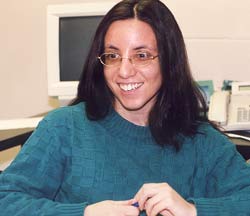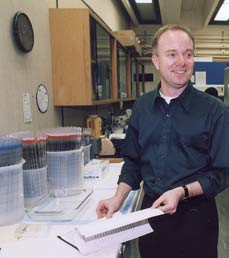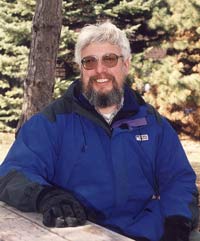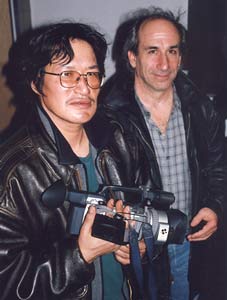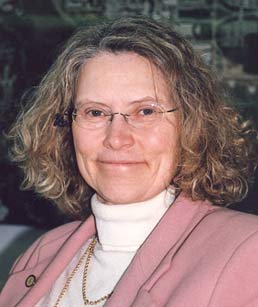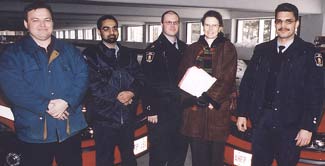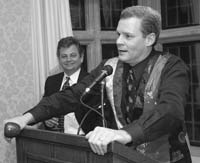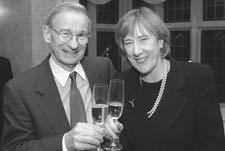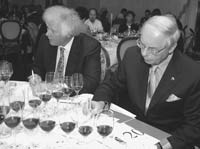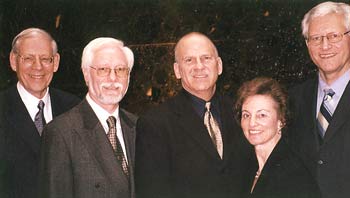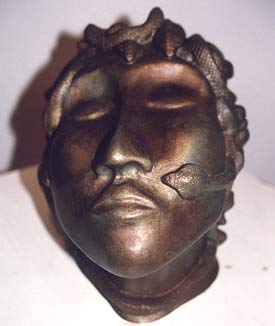|
|||||||||||||||||||||||||||||
|
|
|||||||||||||||||||||||||||||
| | |
| | VOLUME 32, NUMBER 14 | WEDNESDAY, MARCH 20, 2002 | ISSN 1199-5246 | |
| | ||||||||||||||||
|
 |
CFI funds York research on cancer pain, insulin resistance, and the health of Ontario's inland lakes By Susan Bigelow Recent funding awarded by the Canada Foundation for Innovation (CFI) in three new research areas at York University will help to establish Canada's first, multi-institutional research team studying cancer pain, and will open the way to new therapies for diabetics. It will also help build a field laboratory in northern Ontario to quantify and assess environmental damage to inland lakes. Awarded under the CFI's New Opportunities Fund, the grants provide infrastructural support to new researchers at the university to ensure they have access to the advanced equipment and facilities they need to conduct leading-edge research. Research undertaken by York's latest round of recipients is profiled below.
Cancer Pain Research:
Lucia Gagliese
Prof. Lucia Gagliese, a health psychologist at York's School of Kinesiology and Health Science, is establishing Canada's first multi-institutional, multi-disciplinary research team studying cancer pain, at the University and the University Health Network. The team will focus on more effective assessment and management of pain, documentation of the psychological and social needs of patients, and identification of appropriate care strategies for disadvantaged and under-served groups such as the elderly or cognitively impaired. Gagliese notes that pain management services in Canada continue to be inadequate, and experts in the field are urgently needed. As the population ages, the number of cancer patients is expected to grow dramatically, creating a tremendous demand for effective and affordable care. Gagliese is well-known for her investigations into age differences in pain research that belie the notion that chronic pain is a normal part of aging. Her empirical testing of commonly held assumptions about pain in under-studied and often under-served groups has driven her to the forefront of research in the field. Her studies have shown that elderly people do not accept chronic pain as a normal part of aging, and they suffer significant emotional stress because of their pain. She has found that cancer pain in particular is often poorly managed due to inadequate assessment of pain, especially among the elderly and those unable to verbally communicate. The consequences of this are serious, as unrelieved pain is associated with immune suppression, respiratory depression, cognitive impairment, psychological distress, functional limitations, and hastened progression of the disease. Gagliese is seeking to improve the quality of life of growing numbers of people with cancer, by demonstrating that pain is a multi-dimensional phenomenon that requires assessment at the psychological and cognitive levels as well as the physiological. Her work brings together experts in the fields of pain, mental health, palliative care, pharmacology, and anesthesiology. Her grant from the CFI in the amount of $425,000 will help to build a world-class research facility to support her work at York University and Princess Margaret Hospital, University Health Network. Princess Margaret Hospital and its research arm, the Ontario Cancer Institute, are global leaders in the fight against cancer. The University Health Network is one of Canada's largest acute-care teaching organizations, comprised of Toronto General Hospital, Toronto Western Hospital and Princess Margaret Hospital.
Diabetes and Obesity: Gary Sweeney Prof. Gary Sweeney, a biologist in the faculty of Pure and Applied Science, is researching the cellular and molecular basis of the development of diabetes in obese individuals. The success of this research is critical to improving prevention of the disease, and developing therapy for the complications associated with it. These complications include kidney disease, the principal cause of death among diabetics; nerve disease which frequently results in amputations; retinopathy leading to blindness; hypertension; heart failure, and stroke. Diabetes is a major health problem in Canada and the incidence is growing as obesity among the population increases dramatically. More than 80 per cent of obese individuals develop insulin-resistance resulting in type 2 diabetes. Type 1 diabetes (juvenile-onset diabetes) occurs when the pancreas is unable to produce insulin, and can be treated by insulin administration. However, 90 per cent of diabetes cases are type 2 (adult-onset diabetes) characterized by resistance to the actions of insulin and an inability of the pancreas to secrete enough insulin to overcome this resistance. More than two million Canadians have diabetes, and the World Health Organization estimates the global diabetes population will reach an alarming 300 million by 2025, principally due to the rising incidence of obesity. Also of great concern is the prevalence of obesity in juveniles, leading to an increased incidence and decreased age of onset for type 2 diabetes in a population previously unaffected by this type of disease. Sweeney's research program employs the latest in proteomics technology, and is unique in its use of cultured human cells, animal models and Drosophila flies used in genetic research. He uses Drosophila studies to perform RNA interference of gene expression, a novel technique that is possible because many of the proteins of relevance to insulin are conserved across species. Proteomics, the next stage of research after the mapping of the human genome, is the study of proteins in a cell and how cells are using genetic information. Sweeney's work integrates state-of-the-art proteomics technology with cell and molecular biology to understand the association of insulin resistance and obesity at the molecular level. His collaborations with industry, and with researchers in Canada and internationally are expected to yield results of international significance. His award of $529,000 from the CFI will help him to establish his laboratory at York University. The Health of Ontario's Inland Lakes: Norman Yan
Prof. Norman Yan, a biologist in the faculty of Pure and Applied Science, is one of the world's foremost experts on the impacts of multiple environmental stressors on the animal plankton of inland lakes. Recently known for his research on the spiny water flea that has invaded Ontario lakes and threatened plankton biodiversity, he will now establish a Field Laboratory for the Assessment of Multiple Ecological Stressors (FLAMES) on zooplankton. The FLAMES lab will look at the joint effects of several, current environmental problems in Canada's soft-water lakes including pollutants, climatic change, and invading species and their effect on the plankton. Yan notes that boreal shield lakes are often exposed to acid rain, climate change, excess nutrients, and invading species all at the same time, so the traditional approach of dealing with environmental problems one at a time is essentially flawed. The FLAMES lab will be built on the site of the Ontario Ministry of the Environment's world renowned Dorset Environmental Science Centre in the Muskoka region, providing unparalleled access to many different lakes subjected to a variety of stressors of national and international significance. The research will be based on ecological changes detected in the world's best long-term, large-scale data sets on animal plankton, and will seek to identify the causes of these patterns. The stressors examined will be those suspected of having the largest impact on biodiversity in the world's fresh waters. The results will help policy makers manage the impact of multiple environmental stressors, and help the metal mining and energy sectors determine whether the interaction of these stressors are compromising the recovery of inland lakes from historical damage. Yan has been awarded a CFI grant of $506,119 toward construction of the FLAMES lab. In an upcoming issue, Gazette will profile one of the largest social science projects ever funded by CFI, led by York sociology Professor Gordon Darroch. The Canada Foundation for Innovation was established by the Government of Canada in 1997 to strengthen the capability of Canadian non-profit institutions to carry out world-class research and technology development. Susan Bigelow is the media coordinator, faculties and research with York's Department of Media Relations.
| |||||||||||||||
|
 |
Be ignorant - but not too ignorant, says Nobel Prize winner Polanyi By Cathy Carlyle 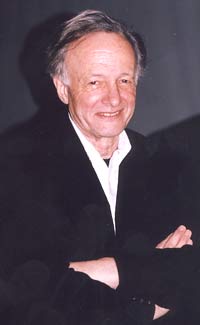
Nobel Prize winner John Polanyi at York "It's a good idea to be a bit ignorant when you go to a good university - but only a bit ignorant," said John Polanyi, recipient of the 1986 Nobel Prize in Chemistry, "and expect to benefit eventually from good luck. You'll also have bad luck, lots of it." Speaking recently to a large crowd of students, faculty and other listeners at York about "A Life in Science", Polanyi chatted about the paths that took him from England to Toronto. He reminisced about the days when he toyed with entering the humanities but instead opted to study chemistry at Manchester University and later went as a postdoctoral fellow to Princeton University and the National Research Council in Ottawa. "People might wonder, why even go to university? How does this place differ from high school? The answer is that faculty members are not engaged in just transmitting knowledge, but in adding to it through their research. At university, you have to educate students for the coming decades, rather than about only the past, as high textbooks often do." No 'Teach Yourself' research books Polanyi said he "gets inspired" by attending scientific meetings and imitating researchers, "much as you would imitate people in movies". Imitation is the best way to learn about conducting research "because a researcher is doing something pretty mysterious. There aren't Teach Yourself About Research books. "It takes guts to do research," he said "because you have to have a willingness to answer questions, even if you might arrive at the wrong answers. And you have to admit to making a mistake, accept the pain of it and reshape your work. If you dare to do all of this...then you will be on your way to become a civilized person." He gives a lot of credit for his career success to his family environment, where there were parents interested in ideas and shelves stocked with books. "On good days it was truth that was important to us, not who arrived at the right answer." Polanyi said he was blessed with "extraordinary good luck" because, just as he was entering university new technologies were burgeoning, in particular, the chip for sensing infrared. "And what did I learn at Manchester University? To ask fairly large questions and, more than that, which questions to ask." Big battle going on Later in his talk he touched on how research is funded. "There's a big battle going on between funding research on the basis of commercial potential versus funding it on the basis that it will change people's thinking, said Polanyi. "I see a tremendous pressure to give money - which comes through our taxes - to branches of science that can be seen to be wealth-generating. That sounds attractive, I know." However, to prejudice the decision "with some lousy guess" as to the commercial value of the research "is to get the taxpayers not more but less for their money. It's a mistake," said Polanyi. "If the research is going to change people's thinking a lot then you cannot find a better investment in the world of academe than that." His own research resulted in a hugely successful vibrational-motion laser, the most intense source of infrared that exists, which generated a $2 billion market. "Yet, if you had wanted that sort of infrared source, would you have given money to people who were studying the most feeble infrared that can possibly be detected? The answer is no - so you would not have got that laser." Should scientists speak about politics? Polanyi is well-known as a promoter of peace and has written extensively on science policy, the control of armaments and peacekeeping. During his talk he raised the question of why scientists should feel entitled to comment on the political scene. "I think it's because they have some credibility, as do any scholars. They are interested in truth. They haven't all been bought by a department of defence or some company. If they are at a university, they belong to a community that transcends nationality, religion, ethnicity and gender boundaries. It's an international community," he said. In his youth he and a group of like-minded people agitated for Canada to renounce nuclear weapons. The group itself was renounced for its hypocrisy "because we were seen as sheltering behind the nuclear weapons of the United States. The critics had a point. "To the extent that today we shelter behind nuclear weapons, we are all heavily implicated in planning an attack on civilians. We need to...consider whether, in fact, we are not morally obliged, in a world recoiling from terrorism, to agitate a lot more strenuously for the retirement of nuclear weapons." John Polanyi's talk was sponsored by the York Chemical Society and the Department of Chemistry.
| |||||||||||||||
|
|
York Centre for International and Security Studies debates Canada's Role after 9/11 By Carol Bishop The world post 9/11, the day the World Trade Centre disappeared, is a major preoccupation of politicians, the media and academics. The 9th Annual York Centre for International and Security Studies (YCISS) conference titled "Peacekeeping or Gatekeeping?" grabbled with the issue of Canadian security policy after Sept. 11. David Dewitt, YCISS director, described the recent two-day conference as "an intellectual journey bringing forward the linkage between international and domestic security issues.". The organizers welcomed back Reg Whitaker, York University Emeritus Distinguished Research Professor (adjunct professor at University of Victoria) who took part in a panel with Sharry Aiken (York), Audrey Macklin (U of T), and Howard Adelman (York) on "The Politics of Gatekeeping". Whitaker is one of the leading authorities in the study of political parties, federalism, security and intelligence, immigration policy and the history of political thought in Canada. His work on Canadian security and intelligence have brought him considerable praise and attention worldwide. He appeared before the Justice Committee of the House of Commons on Bill C-36 and has appeared as a expert witness in a number of high profile immigration security cases. Whitaker's main message was that 9/11 precipitated or pushed forward rather than formulated forces and processes already at work within the United States and the West. Here are excerpts from his presentation. "... In the era of globalization and borderless threats, the problem had to be redefined: how to police not national territory but the space of flows? How to reconstitute Leviathan - as a multilateral enterprise or perhaps as the USA, the world's only superpower. There were many powerful forces working toward a global solution to the policing problem. Generally, this could be seen as a hybrid between a multilateral and an American Leviathan, with awesome surveillance capacities. But these forces also faced numerous contradictions. Take money laundering - general agreement that something had to be done and that a US-led global surveillance regime was the answer began to fall apart when individual corporate actors realized that Uncle Sam was going to be peering into their financial transactions and those of their clients. Progress faltered, stuttered, became bogged down. Then 9/11 unblocked the process when Bush noted that the financing of terrorist cells could be tracked and stopped by pursuing the money laundering trail, and that it was the firm resolve of his government to do exactly that. Since the terrorists had destroyed the very citadel and symbol of global finance, the World Trade Centre, transnational capital quickly lost its scruples about maintaining the sanctity of its clients' financial information. 9/11 simply accelerated a process already well in place but not fully up to speed. How does this translate into the treatment of refugees in Canada? 9/11, it is said, has caused a reversal of Canada's priorities. A human rights and humanitarian discourse surrounding refugee movements has quickly been superceded by a national security discourse, with dire consequences for genuine refugees. Harmonization of immigration security policies and practices with the US as a part of a perimeter security agenda to avert economically costly border controls would, some have argued, undermine Canadian sovereignty, and make us less liberal, less tolerant, more like the security-conscious Americans. I argue on the contrary that we are not seeing a reversal but an acceleration of trends already evident well before 9/11. [Canadian] refugee policies post-9/11 are pretty much like refugee policies pre-9/11, but more so. ... Would a harmonized immigration security system with the US force render changes in the Canadian way? I can't see how. We have for some time operated on much the same assumptions about who are admissible and who are not, we have common data bases on who are the bad guys and which are the bad countries and organizations. Our basic motivations are the same - not to let legitimate humanitarian considerations get actively in the way of the protection of national security from terrorism and crime. Besides there is much that is distinctive in Canadian immigration policy that will remain untouched by security harmonization." The annual conference is an opportunity to showcase the scholarship of YCISS graduate students debating issues dealing with international peace and security. Panelists at the two-day conference included Kyle Grayson (York), Frédérick Guillaume-Dufour (York), Wesley Wark (U of T), Elizabeth Dauphinée, Stéphane Roussel, Hepzabah Muñoz-Martinez (York), Martin Shadwick (York) and Stanley Cohen (Federal Department of Justice).
| |||||||||||||||
|
|
Board of Governors Synopsis
Synopsis of the 372nd MeetingAt its 372nd meeting held on Monday, Feb. 25, 2002, the Board of Governors of York University:
Harriet Lewis
| |||||||||||||||
|
|
Success of Genie Award-winning Inuit video "a dangerous moment"
Film director Zacharias Kunuk and producer Norman Cohn
The day after his dramatic feature Atanarjuat won five Genie Awards, Inuit director Zacharias Kunuk and his producer Norman Cohn came to York to talk to film students.
Kunuk, photographed the night before in tux and silver tie, brandishing a Genie and grinning, had appeared in all the major Canadian newspapers. Atanarjuat, the first dramatic feature made in Inuktitut, had swept the Canadian film industry awards, winning for best picture, director, screenplay, editing and original score. Winning the Genies topped a year of winning major prizes at a host of international film festivals, including Cannes. And there's a good chance Atanarjuat could win best foreign language Oscar at the upcoming Academy Awards.
Tuxedo shed, the soft-spoken Kunuk arrived wearing black leather jacket and blue jeans. He cradled a digital video camera, smaller than the wide-screen digital Beta Cam video camera he used to make his first full-length dramatic feature. Cohn arrived with a cell phone in his pocket.
The media chase was on. Reporters rang three times during the talk to schedule interviews. Cohn, an ex-New Yorker and video artist who does most of the talking, obliged and hardly skipped a beat. "No, I'm not sleeping, I'm giving a lecture." "Hi, I'm speaking to an audience of 1,000."
In fact, they were speaking to an audience of about 30 York students and faculty gathered for the first of three Department of Visual Arts lecture series on Inuit and First Nations perspectives. Before they fielded questions, they showed Atanarjuat's flight from murderers over the spring ice, a riveting segment from the 160-minute historical thriller filmed in Igloolik.
Atanarjuat opened in Canadian theatres on April 12 and will open in the US on June 7. Audiences may never see it as digital video, says a rueful Cohn. In cinemas, they will see a 35-mm film copy of the master video. And when it becomes available in video stores, they will likely see copies from the film copy. Maybe television stations will broadcast the digital version, he said.
Story Based on Inuit Legend
The story is based on an ancient Inuit legend of a shaman who brings discord to a nomadic Inuit community. Families who have lived together for centuries turn against each other in a struggle of love, jealousy, murder and revenge.
The popular epic was scripted by the late Paul Apak Angilirq and produced by Igloolik Isuma Productions Inc., Canada's first independent Inuit production company. Established by Kunuk, Cohn, Angilirq and Paulossie Qulitalitwo in 1990, the company produces video and audio documentaries and series for television, radio and now the Internet. Atanarjuat is Isuma's first feature-length drama. It cost $1.96 million to make with support from Telefilm Canada and the National Film Board.
Atanarjuat has excited the film industry for its medium as well as its content.
"One of the reasons it was such an unusual film at festivals this year is because it is not a film," Cohn said. It is a video.
"The intersection between video and film is brand, brand new," said Cohn. "People like us know about it. Video is not just the minor leagues of filmmaking and filmmakers don't realize it."
This was the first time Kunuk and Cohn followed a full-length script. "One thing we realized is that if you work hard on a script there is hardly anything to do when you make the film," said Cohn. But "we shot it filmically, doing multiple takes of the same shot."
Timeless look
The film has a timeless look and puts the lie to modern myths about dying native cultures and languages, said Cohn. "There were no styrofoam igloos, no rubber harpoons." Actors were at home speaking Inuktitut, wearing skins and furs, and roaming a landscape that hasn't changed in thousands of years. To see a modern actor disappear over a hill and return as if he had stepped out of the 16th century was a stirring moment for Kunuk. "It's a very hallucinating experience in that environment because so much hasn't changed," added Cohn.
In fact, two days after visiting York Kunuk and Cohn planned to go hunting. "We just changed the dog teams to snowmobiles and hunt the same way," Kunuk deadpans.
Atanarjuat was made for an Inuit audience. "We know who our audience is," said Cohn. "We cannot compromise that audience to please you" [in the south].
They have captured their northern audience and inspired other aboriginal groups around the world to tell their stories. Inuit children especially are enchanted with Atanarjuat. They chant his name and act out the story the way American kids play cops and robbers.
For their next project, Kunuk and Cohn are planning another historical drama when the traditional world of Atanarjuat confronts the imported world of Christianity. With the world watching and success finally flowing their way, Kunuk and Cohn are wading through proposals, planning their next project, hoping to remain true to their mission and ride the wave of success without getting swept away . "It's a dangerous moment," said Cohn
| |||||||||||||||
|
|
Call for applications for Winters College Academic Advisor
Applications are now being accepted for the position of Academic Advisor in Winters College. Candidates must be associated with York University and have demonstrated an interest in and knowledge of undergraduate education. Preference in this search will be given to candidates associated with the Faculty of Fine Arts.
The College Academic Advisor is a part time position. This position serves as the chief assistant and advisor to the Master of the College with regard to academic matters, organizes co-curricular support for academic programs related to the College mandate in Fine Arts, organizes the College's first year academic orientation, and serves on committees as required. The principal role of the Academic Advisor is to offer academic support to undergraduate students in Winters College according to their needs.
The appointment is normally for a three-year term, which is renewed annually and would begin July 1st, 2002
A letter of application including three references should be addressed to the Chair of the Search Committee for Academic Advisor, Office of Master, Room 278, Winters College.
| |||||||||||||||
|
|
Departing VP prepares York for double cohort
Phyllis Clark
This spring Phyllis Clark leaves York University after five years as vice-president finance and administration to take up a similar position at the University of Alberta. At York, Clark has been responsible for four crucial administrative areas: Facilities, Construction and Maintenance, Campus Services and Business Operations, Finance, Human Resources, Safety and Security. As she prepares to bid farewell, The Gazette asked her to reflect on her accomplishments and challenges.
Q: Performance seems to be a priority for you, judging by your division objectives in Planning, Budget & Accountability Report 1999-2000. You have encouraged your departments to monitor and refine performance, always taking the pulse of clients. You have designed a survey of effectiveness of your division's services to the president and vice-presidents. Why are performance goals and measures so critical? How have they improved service, client satisfaction and efficiency in your division?
A: Administrative services at universities really deliver the second level of services to the institution. The first level is the academic delivery. So you have people teaching, you have people doing research, you have people working at the library, but always sitting in behind them are the administrative services. It's really important for those areas not only be efficient in what they do but also to give good customer service to the people that are delivering these services to students and doing research. And it's tough to measure how good that service is. So having a third party or an objective measurement of how well you're doing that job is helpful.
I think administrative service was always good at York. I wanted to measure what we do and how well we do it. Sometimes we see what's convenient for us as compared to what's convenient for the customers so it's a good idea to ask them what they want to have, how they want to have it delivered and whether we are doing a good job of delivering it. People at York care a great deal about the University, so I think they want to do a good job. It's just a question of making sure that all of that energy is devoted to what the job should be.
Were there some rub areas where people thought they weren't getting good service? Yes. Have we initiated programs to try to address that? Yes. Unfortunately, I won't see them come to fruition, but there will be better services because of customer feedback. However, in the kinds of jobs and tasks that are done in the administrative area, there is never enough money, there are never enough people, and there are lots of messy issues. It's never going to be perfect. We just have to continuously get better at what we do and measurement will help that.
Q: The double cohort of undergraduates in 2003 will have a major impact on food services, student residences and security, among other things. What can we expect as your division prepares for this swell in the student population?
A: The double cohort will have a huge impact on the academic side, but it will also have a big impact on administrative services. Things like housing - we're going to build a new 300-bed residence - and parking - we're putting in two parking structures to provide new parking spaces as well as make up for lost parking spaces. We're going to have to have different kinds of food delivery areas. There will be more people and younger people on campus, so we have to take that into account as we deliver security. Keeping the rooms clean and in good condition is going to take more cleaners, more maintenance. Then you have the people in human resource area and finance who will be backing all the changes; for example, by issuing more payroll cheques.
How are we going to do this? I hope more efficiently because we're not going to get as many people as we think we would like.
Q: The chase for a parking space has become ever more frantic as more people drive to York. Tell us about your division's solutions - the new parking structures and the long-term parking plan.
A: Parking is becoming more of an issue as we move towards double cohort and as the campus expands. The President's Office is working very hard on a subway or dedicated bus lanes. Our transportation people are working on public transit arrangements with TTC, Vaughan Transit, GO Transit - both for buses and trains. We're working with Vaughan on alternative parking solutions. And we're putting up more parking structures close to the academic core, in keeping with the master plan. We've put up some temporary parking lots to try to take care of some of the overflow, but parking structures are clearly the long-term solution.
Q: Labour relations at York are often challenging. How would you assess the current state of labour relations?
A: It's very good. We had 15 years of labour peace and then two strikes. Two strikes since 1987 is a very good record. They were very long strikes and very difficult strikes, there's no question about that. But for most of that period we must have settled over 100 contracts. Generally, I think our unions are extremely responsible. Also I think that we are careful as the University's administrators in terms of how we deal with unions. Since the CUPE (Canadian Union of Public Employees) strike we've settled some issues about benefits to our mutual satisfaction and we've also been participating in the time and value meetings as prescribed under the CUPE contract. We've got a big round of bargaining this year with CUPE 3903, CUPE 1356 and 1356-01, YUSA and the International Union of Operating Engineers. So it's going to be a heavy year. But, you know, I would say relations around York are good. And that goes to the underlying good feeling that people have about York and working at York. They really like it. I really like it.
Q: As a former assistant deputy minister and chief economist for Ontario, you brought impressive credentials to your position. You came here as York, like many universities, was searching for a way to reduce a deficit. What was your role in helping the University develop a long-term plan and begin reducing its deficit?
A: I built on some very good work that had already been done at York. There were multi-year budgeting plans for both the operating budget (academic) and for the ancillary budget (support services).
On the operating budget side, we lengthened the planning horizon and integrated all the budgets with the financial statements. And we've got a very sophisticated capital plan in process now for the budget.
In general, we've got better tools, but the same philosophy still holds about responsible budgeting. We've got a very responsible board and University executive committee that knows that short-term deficits aren't reasonable for a university and are not a solution to long-term problems like lack of government funding for general costs. I'd say I've continued what other people have done, maybe sharpened it, but built on a very good foundation that York had for budgeting.
Clark in 2000, (second from right) with staff members (from left) Dragan Spasojevic, Muhammad Aleem, Shane Budgell and Dan Welk in the York Lanes Parking Garage.
Q: Looking back, what are the highlights of your experience at York? What are you most proud of achieving and what can you see as continuing challenges for your successor?
A: York just floated a $200 million bond this year. That's so exciting. We needed to raise money to do this big expansion for the double cohort and this was the cheapest way to borrow the money. York is only the third Canadian university to raise money this way. We are in a solid financial position and rated on a par with the University of British Columbia.
Fair funding - the $14 million that came into York to support the academic mission - was a big one. It really was a march toward equity for those universities. It was great.
I'm also proud of improving benchmarking. Individual areas had comparators that they looked at, but I don't think that they were measuring them over long periods of time. When you start to look at a group that you're comparable to you can get ideas of how to do things better, more efficiently, more effectively and you can just get new ideas of things you can do on the administrative side. So I think all of that kind of thing is good and sometimes it's good to be reinforced for things that you've done well at York. And I don't think we celebrate our own successes frequently enough.
Other things I would highlight?
We've got a good occupational health and safety management system. We're required by law to manage health and safety, but we've now got a really vibrant way of doing that.
We bargain under a total compensation framework which is very good. That's a very powerful framework for getting to mutually agreeable settlements.
The appearance of campus is excellent and changing and I am proud of both. Superbuild gave us $77.5 million - the biggest grant from the province - for new buildings. In terms of the architecture, the new buildings are or will be spectacular - the Computer Science Building, Schulich School of Business, the new Technology Enhanced Learning Building, the award-winning Honour Court. There's been a lot of work done to beautify the campus - planting trees at the arboretum, improving grassy expanses, putting flowers around campus. The Commons has come to maturity now so I think the campus looks great.
Though we are a very safe campus, we've taken steps to make this campus even safer. We've introduced Roadwatch. We've expanded CCTV (the surveillance cameras in parking lots) and car thefts have plummeted.
Q: You have been at York for a total of six years. What parting advice and farewell comments would you like to make?
A: I think York is just a fabulous university and I've liked working here a great deal. It's just been a marvelous experience for me and I'm very grateful that I was hired. I worked with good people at the University executive committee. The opportunity to work with Dr. Marsden's been wonderful. She's a great leader.
The people that work for me and report to me have taught me a lot. They're very decent, talented, good people, so that's been a great experience.
York is probably the most underrated university in the Ontario system. My only advice would be to be proud of York and tell others that it's a great university and it's a fine place to work.
Clark in 2000, (second from right) with staff members (from left) Dragan Spasojevic, Muhammad Aleem, Shane Budgell and Dan Welk in the York Lanes Parking Garage.
| |||||||||||||||
|
|
Call for applications for Calumet College Academic Advisor
Applications are invited for the part-time position of Academic Advisor of Calumet College. Candidates should have an interest in, and knowledge of, undergraduate education and the development of the College mandate - Technology and the Arts. Advising students is the core of the work. Additionally, the position includes advising and assisting the Master of the College with regard to academic matters, organizing co-curricular support for the Foundations courses related to the College, organizing the College's first year Academic Orientation and serving on Committees as required.
The appointment is normally for a three-year term, renewable annually, beginning July 1, 2002.
Please address applications and/or questions to the Chair of the Search Committee for Academic Advisor, Professor Peter Roosen-Runge,
The deadline for applications is April 12, 2002.
| |||||||||||||||
|
|
The Journal
THE UNIVERSITY OF THE ARCTIC has introduced its first online course, "Introduction to the Circumpolar World," as the first step toward a bachelor's-degree program in circumpolar studies. The goal is to train a new generation of leaders who can deal with policy issues for the world's northernmost regions across national boundaries.
chronicle.com/free/2002/02/2002021501u.htm
.
* * *
A GLANCE at the winter issue of ADE Bulletin - "Embracing the corporate university". Are humanities chairmen helpless in the face of university "corporatization"? Not in the least, suggests Reed Way Dasenbrock, a dean and professor of English at the University of New Mexico at Albuquerque.
To start, he observes that the university's "engagement with the cash nexus" is far more varied than the phrase "corporate university" suggests. Research universities, "credentialing" universities (in which the student buys "essentially a credential, not an education"), and liberal-arts colleges are all different animals, he says, that "can't be lumped together as a single development" called corporatization.
If department heads in the humanities don't want to be so vulnerable to "the pricing pressures driving the Wal-Mart University", they have two possibilities, he writes. One to is focus on increasing the endowment income that is available to their department, and the other is to emphasize attracting grants. Department heads "are essential to the successful pursuit of any resource-acquisition strategy," writes Dasenbrock. In addition to pursuing both federal and foundation support, he advises department heads to pay attention to development issues and "connect to [the] university's quest for private donations."
Too many in the humanities, he says, are quick to deplore their "abandoned status" when it comes to financial support but are unwilling to play a role in their institutions' fund-raising efforts. A "posture of aggressive independence from factors of corporatization" is no longer tenable, he concludes.
The article is not online, but information about the journal is available at www.ade.org/bulletin/bulletin_about.htm.
| |||||||||||||||
|
|
In Brief
What's CSBO? Check York's new Web site!
York's Campus Services and Business Operations has a new Web site. What's it all about? The Web site aims to provide services that improve life on campus. It has information about everything from textbooks, printing services and transportation to the University to finding a place to live, shop and park. As the site says, "Our task is to meet your expectations for high-quality service." Visit them often for updates on events and service improvements. The address is
http://www.csbo.yorku.ca/
and the email address is csbo@yorku.ca.
York faculty have Killam renewals
York's Ellen Bialystok in Psychology and Steve Mason in Classics and Religious Studies have been awarded the renewal of their Killam Research Fellowships for a second year. Mason's research is "Flavious Josephus: An Introduction" and Bialystok's is entitled "Bilingualism: Into Adulthood and Beyond". The fellowships, one of Canada's most distinguished research awards, are provided through the Canada Council for the Arts, and are made possible by a bequest of Dorothy J. Killam and by a gift she made before her death in 1965. They are intended to support scholars engaged in research projects of outstanding merit in the humanities, social sciences, natural sciences, health sciences, engineering and interdisciplinary studies within those fields.
Honours for York students at model UN conference
Four York students walked away with honours at the February Harvard National Model United Nations Conference (HNMUN). Fourth-year student Muthu Padmakumara and second-year student Michael Garfinkle won Best Delegate awards; and second-year students Susanna Kislenko and Tanya Zigomanis were given honourable mentions. HNMUN is the largest, oldest, and most prestigious UN simulation conference of its kind, and the York University Model UN (YMUN) team has been among the top five contenders during the past five years. Each year, HNMUN brings together nearly 2,000 students and faculty advisors from colleges and universities worldwide and gives them an opportunity to experience the challenges of international negotiation.
York's 'high-flying' prof reports in
York natural sciences professor and pilot Daphne Schiff has reported in. She and her co-pilot, who have been on a voluntary aid mission with Paris-based Air Solidarité with those on 22 other small planes, have been delivering health and educational materials to remote African villages. (See Sept. 26, 2001 issue of the Gazette.) In a recent account of her journey, she said she faced poor visibility, extreme heat (48 deg.), constant and erratic turbulence, numerous stray dogs on runways, military activity in several areas, and extreme challenges in navigation. At times she slept on the sand under a straw canopy or under mosquito nets over sleeping bags. Sometimes being able to shower was a luxury, since water sources has dried up.
"Our arrival (at her destination of Bogandé in sub-Saharan West Africa ) was an event!" Schiff said. Some of the people who lined the runway had walked 15 hours in the heat with babies on their backs. "We shared their joy by welcoming them to climb on, around and through the aircraft. Celebrations continued that evening: speeches from the mayor and dignitaries in colourful costumes. Then came the synchronized drum beating and unique folk dancing."
In closing, Schiff said she would never forget the joie de vivre and warm welcomes at every stop. "Nor will we forget the feeling of flying in a turbulent atmosphere. It was much like riding a camel."
York design student wins international digital art award
Graham Huber, a second-year design student in the York University/Sheridan College Joint Design Program, has won the top student award in the international Seybold Seminars Digital Art Competition. This is his second international digital art award in two years. Last year he won first student prize at the Macworld Expo 2001 in San Francisco. The Seybold competition winners were announced in February at the Seybold Seminars in New York. The seminars showcase the latest technology and bring together leaders and innovators in the publishing and printing industries in North America. You can eye Huber's winning image at
www.seyboldseminars.com/digitalart
and in Secrets and Insights of Award-Winning Digital Artists, a digital art book written by Jeremy Sutton and Daryl Wise, to be published by Hungry Minds this summer.
| |||||||||||||||
|
|
Air pollution knows no borders
ast year's grantees of NSERC Research Grants Professor John McConnell of the Earth and Atmospheric Science department and his research group and collaborators are contributing to this understanding by the creation of multi-scale global air quality models.
Previously models of air pollution have tended to concentrate on urban and regional emissions taking place over a relatively short period of time, typically for a few weeks. McConnell and his collaborators are using global models to provide a more comprehensive view of the impacts of air pollution.
"We're looking at details of air pollution with time scales from months to years," he explained. "But the group is also looking the effects of air pollution on much longer time scales from tens of years to hundreds of years.
We used to look at pollution in urban terms, and then regional terms. Now we finally are beginning to realise that we must look at it in global terms. In fact, our best estimates are that air quality is beginning to have an impact on climate."
Recognising the temporal and global aspect is only the first step in the overall project. Of utmost importance is the integration of local, regional and global measurement data into the computerised modelling system that spans the whole planet.
To do this, satellite data is invaluable, especially for data on the global scale. Although satellites may miss some detail (since the data sometimes have to be averaged over regions three kilometers thick, and hundreds of kilometers wide) the wide-scale coverage they can provide is essential. There are also some things that you can't measure from a satellite, such as the gas OH, also called "atmospheric detergent", which is very reactive and vital to the destruction of methane, ammonia and hydrocarbons, species that are important in both air quality and climate. For these reasons, the project will also integrate information gathered from aircraft (such as planes and balloons) and earth-bound measuring devices.
Then there is the issue of what you do with this data. "You get the results, but what do they mean?" McConnell said. "You have to build the models to try to interpret this information. The more complete the model, the better you can interpret the results." Modelling projects integrating the whole planet must, of necessity, include many, many researchers and many institutions, both university and governmental. Information for the models comes from many different sources throughout Canada and the rest of the world. Satellites have a great number of researchers vying for precious space - atmospheric science being just one field trying to get equipment into them - so data coming from them is shared.
McConnell also gives other reasons for collaboration: "A satellite is very expensive, and a single person does not have the expertise for everything. In order to make things comprehensive, you want to draw together a lot of expertise."
The models will simulate air pollution movement based on this shared expertise, and then project this data forward to anticipate potential particulate movement. They will be able to understand the impacts of pollution at global and regional scales.
"To do this, we need a very flexible model," said McConnell. "As an example, we are working with researchers at the Meteorological Services of Canada (MSC) and adding a capability to calculate global air quality to the MSCs weather forecast model. This will allow us to go from the global scale but still focus on specific regions of the world such as North America. In our team we have researchers on the East Coast, the West Coast, Montreal as well ourselves.
Each of these groups will focus, on an even more detailed scale, in their respective areas - for example, the Vancouver region , which gets infrequent but very bad air pollution, will be the focus of a special study which will be very interesting on account of its unique geography. The idea is that it's multi-scale air quality modelling. You can look at the global and see how it might be affecting the regional."
The basic need for this is that air pollution really is a global problem. Ontario æexports' air pollution, not only to other areas of Canada, but across borders into Europe. A significant amount of European pollution is transported into Asia, and some Asian pollution makes it across the Pacific to impact North America, to some degree. McConnell explains: "Anything that's relatively long lived - by that I mean, will stay up more than two or three weeks - by virtue of the strong winds in the troposphere above us, has the potential to impact at least the rest of the hemisphere, if not the total globe."
One of the issues with this long range transport is that of small particles. From a health perspective they are the most dangerous. Larger particles are filtered out of our lungs naturally, but smaller ones can descend past the alveoli and be absorbed into our blood system. There are natural sources of such particulates, such as forest fires and other types of biomass burning, as well as many human related sources and these can also be studied to assess their impact on humans using both models and measurements. Models are often used as proxies for measurements which are both expensive and difficult to obtain.
We are still a ways away from being able to accurately predict where and how air pollution will move around the globe. However, our outlook is increasing through the improvement in computing power, the improvement of these models, and the forging of collaborative relationships. Hopefully, within the next decades we should be able to forecast into the centuries ahead with more confidence.
Derek Irwin is a master's student in English and writer in York University's SPARK (Students Promoting Awareness of Research Knowledge) program. The program was initiated by NSERC (The Natural Sciences and Engineering Research Council of Canada) in 1999, based on a model developed at the University of Guelph.
| |||||||||||||||
|
|
Senate Synopsis
At its 486th meeting held on Feb. 28, 2002, the Senate of York University:
Next Senate Meeting
4pm on Thursday, March 21, 2002 in the Senate Chamber
| |||||||||||||||
|
|
Wine auction has bouquet of success for York's rainforest program
Auctioneer Hal Hannaford
The prestigious Woody Fisher Fund for Neotropical Conservation event was a tremendous success, raising $50,000 for ongoing research and conservation programs at York's Las Nubes Rainforest in Costa Rica. (See Feb. 20 Gazette article). The top-selling item at $5,000 was a 1971 Burgundy, Romanée Conti DRC. The 1982 Bordeaux sold in a range of about $1,000 each.
Woody Fisher and York President Lorna R. Marsden
A bottle of Newman's Celebrated Port Wine went for $500 (on the condition - fulfilled - that it be opened and tasted by all present). And five pounds of Las Nubes "Premier-Cru" organic, shade-grown coffee went for the startling bid of $500. The coffee, grown in the Las Nubes area, is an alternative to large-scale land clearing for technified coffee plantations and cattle ranches that threaten biodiversity and diminish regional environmental stability.
The Woody Fisher Fund is named for the distinguished Toronto physician who bought the rainforest and donated it to York's Faculty of Environmental Studies (FES) in 1998. Fisher and about 100 fellow wine connoisseurs donated items from their private collection to the auction. With headmaster of Royal St. George's College Hal Hannaford at the helm as auctioneer, the auction was underway.
Doug McCallum, director of the Donald F. Hunter Charitable Foundation, and Joseph Rogers, a noted Toronto psychiatrist and spouse of Miriam Rogers, a Toronto wine agent
Howard Daugherty, FES professor and director of the research program at Las Nubes, said the event supported the University's efforts to protect tropical diversity and to promote sustainable livelihoods for local communities through ecologically-sound agricultural practices.
The funds raised from the auction will be used to build an environmental research centre near the Last Nubes Biological Reserve in collaboration with the Tropical Science Centre of Costa Rica.
| |||||||||||||||
|
|
Globalization and the university
Erhardt (right) with CCGES friends and members of the Advisory Committee: Charles Hantho, chairman of Dofasco Inc., Chair of the CCGES Advisory Committee and member of York's Board of Governors; Willy Heidbuechel, vice-chairman of Eurocopter Canada and member of the Advisory Committee; Jeffrey Peck, director of CCGES; and Claire Horowitz
On March 4, York University was host to an important conference focusing on the evolution of the university in this era of globalization and internationalism.
The conference "Globalization and the University: From Marketing to Academic Mission" was sponsored by York's Canadian Centre for German and European Studies, the Office of the Vice- President Research and Innovation, York International and the Faculty of Education.
Dr. Manfred Erhardt, secretary general of the Donors Association for the Promotion of Science and Humanities, a leading donor organization for universities in Germany, delivered the keynote address. A lawyer, scholar and skilled administrator, Dr. Erhardt has a long-standing relationship with York University. He was instrumental in establishing, 13 years ago with then Premier of Ontario, Jim Peterson, the Ontario Baden- Württemberg University Student Exchange Program now administered by the Canadian Centre for German and European Studies. The program has grown to 1,300 students in exchanges annually. In 1999, he was bestowed with a York U. Honorary Doctor of Laws Degree.
Erhardt set the tone for a stimulating and productive exchange on the pressures of the new market economy on university structures and relationships, a debate that, he stated, is taking place in Germany and sparked the conference. Since globalization has sharpened competition to the extent that "survival of the fittest" comes into play, universities will be subject to the same forces, he told the gathering. "The ability to innovate will decide our fate."
Erhardt believes that, along with our many technological advances, we must ensure the human factor does not get lost. Human beings are needed to use their judgment to process, evaluate and select information that is of value and turn it into knowledge, he said.
York President Lorna R. Marsden, and Vice-President Research and Innovation Stan Shapson opened the conference with remarks on the timeliness of the topic and the continued expansion of international relationships at York.
Dr. Erhardt continues to play a major role in the transformation of the German university system, its structure and curriculum.
Claire Horowitz is the development officer for York University's Research Centres.
| |||||||||||||||
|
|
York Perspectives:
a view of one of the Keele Campus wood lots. "...And in green underwood and cover, blossom by blossom, the spring begins...." - Swinburne
| |||||||||||||||
|
|
Student show sculptures
"Beautiful Contradiction", a Medusa-like head by Christina Vieira, was one of many student sculptures on display at The Gallery in the Joan and Martin Goldfarb Building for Fine Arts Feb. 25 to March 8. This year, the annual student sculpture exhibit also featured puppets, mobiles, stone carvings and multimedia installations
| |||||||||||||||
|
| ||||||||||||||||
|
|
||||||||||||||||
|
|
|
| Current Issue | Previous Month | Past Issues | Rate Card | Contact Information | Search |
|

